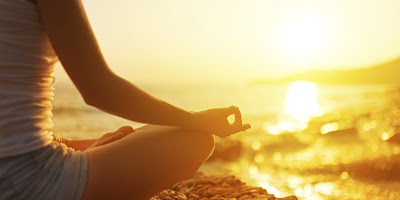Meditation: Beyond the Seated Practice
I'm starting to feel a little overwhelmed as I prepare to teach an upcoming series on meditation. There are so many different traditions of meditation and such a vast wealth of information around meditation practice that it's tricky to figure out how to condense that into a four week beginner series. As I've been trying to figure that out, I've really been thinking about meditation in general--why is it so difficult? Why do so many of us avoid it like a dreaded chore?
Boiled down into a very simple nutshell, it's the practice of sitting and becoming still and connecting with a deeper part of our being. Sounds simple enough. So why is there SO much around this (difficulty, aversion, myriad methods of approach, etc.)? As usual when I ponder things, I began to wonder what the other side's perspective is. Knowing us humans try our best, but still kind of get off track with things, I wondered if our advanced teachers in the spirit plane would have a different perspective or perhaps approach to meditation than we do. What I'm sharing below is their response to my wonderings.
~~~~~~~~~~~~~~~~~~~~~~~~~~~~~~~~~~~~~~~~~~~~~~~~~~
"Meditation is the act of being present. In this sense, you can be meditating when you are driving, walking, eating, conversing, and so on. In fact, this is what we suggest--finding pure presence in everything you do, as a means of practicing meditation. What one needs to ask oneself is this: What is my reason for meditating? What is my intended goal? For some it will be stress reduction. Others will be seeking a deeper spiritual experience. Others are longing to be free from the suffering of the ego mind. Whatever the intention, the true art of mastering such goals is to consistently apply your practice to your daily life.
Meditation is a practice that is often removed from daily life. One makes time, makes space, secludes themselves, shuts out the external stimuli and attempts to get quiet and go within. This is the traditional sitting meditation. While this is a valid practice and one with many benefits, it is not the whole practice. Sitting meditation is one part to a whole meditation practice. To establish true harmony, equilibrium, and peace of mind, one must continue to practice when they are engaged with life. If one sits quietly in meditation for 20 minutes a day but remains primarily unconscious in the rest of their lives, the benefits of meditation will remain minimal. Sitting meditation is a wonderful place to start, but it is by no means the whole practice. It is a misunderstanding to believe that the benefits of seated meditation will automatically translate to the rest of your lives, as if by osmosis, with no effort on your part. A true meditation practice includes both the internal practice of quietude and the application of presence in the face of external stimuli, outside of your sitting practice. These factors combined, this is meditation.
There are so many different variations and teachings on meditations, valuable indeed, but they are primarily focused on this one aspect of meditating; the internal practice of sitting and quieting the mind. It is our opinion that meditation practice continues as you engage in traffic jams, interactions with others, problem solving, conflict resolution, and so on. Meditation is presence. When one is present, or at least is making a conscious effort to be present, in all of their daily situations, this is where the true growth of spirit and benefits of meditation arise. We want to reiterate that we are not diminishing a sitting meditation practice. This is a crucial part of your overall practice. We do however want to draw attention to the disconnect between this type of meditation and the application of presence to other areas of life. It is far less challenging to be peaceful and present in solitude, in the absence of triggering stimuli. The real growth occurs when one is being triggered by particular stimuli (an uncomfortable confrontation or conversation, an angry driver, a disrespectful co-worker, etc.). This is where your true meditation practice occurs. These triggering situations are the key areas to practice--remaining centered, breathing fully, and maintaining presence with the situation so that you may be consciously responsive instead of unconsciously reactive. Your sitting meditations help to prepare the mind for this more advanced form of meditation, which is maintaining presence in the face of such triggering stimuli.
We would suggest that if one is to start a meditation practice, they look at it as a 24-hour commitment, versus a 10-20 minute commitment. Don't let this be daunting. It doesn't mean you are trying to achieve perfection. It means you are trying to achieve presence. Maintaining presence goes against all of the ingrained programming of the busy mind. Sometimes you will achieve it and sometimes you won't. This is why it is called a practice. The more you practice the more you calm the "monkey mind" and the more you come into alignment with the "soul mind". The soul is ever present, ever aware, and always ready to respond in the ways of your greater good. By practicing meditation you begin to quiet the mind chatter to allow a deeper and more prevalent connection to your soul.
Meditation is the way to begin speaking through your soul. This is the place where love is unconditional and perception is clear. This is the place that is not distracted by insecurities and fears. A steady meditation practice --both in solitude and in daily life--allows you to connect deeper and deeper with this part of your self. This is the part of you that has the wisdom to solve conflict without harm or violence (verbally or physically). It is the part of you that knows you and your worth are not threatened by external factors and perceptions. It is the part of you that knows just as you are eternally worthy, beautiful, and whole, so is everyone else. When you begin to relate to yourself, to others, and to the world from this space you begin to know peace. This doesn't come from a few minutes of sitting meditation each day. This comes from continued focus and practice as you apply the presence you touch in seated meditation to the rest of your life."
Heather: Do you have any tips on how to meditate, specifically the seated meditation? I know people can experience a great deal of resistance and frustration when trying to do a seated meditation.
"Most importantly, let yourself off the hook. So much frustration comes from having an expectation of what your time spent in meditation should be like. If you go in with the intention of finding stillness and finding presence, that is enough. Some days you will succeed in that and some days you won't. Sometimes you will be still and present for a brief part of the time and agitated in the mind the rest. It's okay. The point is you are practicing. You are establishing new patterns of thought and neural programming. You are giving the body an opportunity to be still and restful.
Whatever the experience is like on any given day, it is a useful teacher. Observe what occurs in mediation. You'll notice how your mind works, where and what it is getting caught up on. This awareness is what allows you to make changes. You can't change habitual thought patterns until you observe that they are there and recognize what they are. When the mind is particularly busy it clues you to what is agitating to you and why. The 'why', if examined, will usually lead you to deeper awareness that can lead to healing; healing false beliefs about yourself, about others, about how things "should" be. This type of healing will bring you closer to a state of presence. And so you see, going into meditation with the expectation of the mind immediately being perfectly silent and still, or of having some blissed out experience, is not always a realistic goal.
To begin a mediation practice, set your intentions and then trust that whatever is showing up for you in your meditation is serving those intentions. If your goal is peace, this will not miraculously occur by sitting and closing your eyes. You must first observe where you are not at peace. If your goal is presence, you must first observe what keeps you from the present moment. Let go of a narrow sighted expectation of your meditation being a certain way. It will be what it needs to be. Learn to lovingly detach and observe what transpires and keep at it. Keep coming back, every day. Keep setting your intentions. Keep trusting and believing that your intentions are being served. From here you don't enter into a meditation with the pressures of strict and narrow expectations. You can rest and relax into the knowing that the experience will be precisely what you need it to be to lead you to the attainment of your intentions. You might discover you need more discipline in focusing on the breath and quieting the mind. You might discover you are too focused on quieting the mind, gripping too tightly. Whatever your mind shows you can be used to step closer to your intended goals. Let go and surrender to the process, staying consistent in your intentions and consistent in your practice. This is the way of meditation."
~~~~~~~~~~~~~~~~~~~~~~~~~~~~~~~~~~~~~~~~~~~~~~~~~~
I took this advice to heart and have been practicing with it for a few days before sharing this so I could offer some personal feedback. I've been meditating for several years and I love it. I do notice that it brings a deeper sense of peace and centered-ness to my life. But I can also see the disconnect the 'other side' refers to between my 20 or so minutes of meditation time and the rest of my life. I typically set time aside to meditate, and then get up and go back to what I was doing. Now, when the 20 minutes of my seated meditation is up I no longer see it as the end of my meditation. I continue to meditate, I just slightly shift focus and begin meditating in an even deeper way-- going from seated and eyes closed, to moving, engaging, working, and living. I keep my breath deep and full. I continue to feel my center. I feel more grounded. Wow. This living meditation is deeply beneficial! It's beyond 'mindfulness'. It's feeling a deeper connection with the energy of life, with what is beyond the surface. It's allowing me to really feel the connectivity of all things, the subtle pulse of life force energy that surrounds us and connects us to everything.
A work in progress to be sure, approaching the entirety of the day as a continual meditation, but it's already creating some fascinating and profound shifts in my perspective and state of mind. I feel like I'm continuing to stay connected to my Higher Self, or soul. A part of me I feel very connected to when I'm in seated mediation, but often don't connect with in my daily routine as I let insecurities and doubts override that connection and steer my course. As I continue to maintain that connection to my Higher Self as I go about my day I'm finding that I have more confidence and compassion and love for who I am. I invite you to experiment with this....treating your life as a moving meditation. Without far-reaching expectations, without attachments to outcomes, just observing, breathing, and staying present.
Blessings and Love,
Heather
heatherwallace.net



Comments
Post a Comment